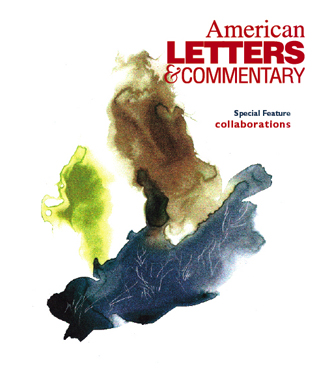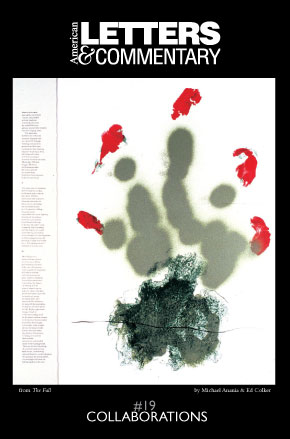
Issue #19
Co-Editors
David Ray VanceCatherine Kasper
Editor Emeritus
Anna Rabinowitz
Cover Art
Ed Colker
The Century Keepsake (2004)

Special Feature
collaborations
Anna Rabinowitz |
Once Upon A Collaboration |
John Dermot Woods & Kristen Iskandrian |
5 Cats |
Joyelle McSweeney & Johannes Göransson |
The Rapid Communication Our Enemy The National Anthem |
Mark Nowak & Ian Teh |
from Coal Mountain Elementary |
Lea Graham |
Out Of Ordinary: The Extraordinary Collaboration Of Michael Anania And Ed Colker |
Michael Anania |
Esthétique du Râle Re: Collaboration with Ed Colker Pochades |

Sean M. Conrey • Matthew Cooperman
• Amy Dickinson • Steffi Drewes •
Amy England • CJ Evans
• Norman Finkelstein • Andrea Fitzpatrick •
Michael Gessner • Michele Glazer
• Hillary Gravendyk • Gary Hawkins •
Kirsten Kaschock • David Koehn
• Nancy Kuhl • Laurie Clements Lambeth
• Jee Young Lee • Dawn Lonsinger •
Mojdeh Marashi • C. J. Martin
• Joshua McKinney • Kat Meads •
Ralph J. Mills Jr. • Jennifer Militello
• B.Z. Niditch • Emily Pérez •
Jennifer Pilch • Zach Savich • H.E. Sayeh
• Lisa Sewell • D.E. Steward •
Stephanie Strickland • Mathias Svalina
• Chad Sweeney • Arthur Sze •
Steve Tomasula • Jasmine Dreame Wagner
• G.C. Waldrep • Rob Walsh •
Suzanne Wise
Artwork:
Ed Colker • Mark Nowak
• Ian Teh • John Dermot Woods
|
ISSUE #19collaborationIn this issue we celebrate the tensions, struggles, successes, compromises, and moments of serendipity that mark the collaborative process. While writing is often thought of as a solitary endeavor, the truth is that literary production depends on collaboration at almost every juncture, both conceptually and practically speaking. If nothing else, the prospect of being read (itself a kind of collaboration) informs so many authorial decisions that the often romanticized notion of the solitary writer seems dubious at best. Writers and artists are constantly working together in various ways and with varying degrees of intentionality, whether by simply responding to one another's works and carrying on conversations or by literally putting pen to the same page. In terms of print production, writers invariably collaborate with editors who in turn collaborate with one another and with numerous people who make a journal like this one possible--”from generous donors like the Oppenheimer Foundation of Houston, to the student volunteers who slice open the envelopes and log in the submissions, to the printers who ink the pages, not to mention the distributors and booksellers who literally get the journal onto bookstore shelves. More to the point, even if solitary artistic endeavor were possible, it wouldn't necessarily be preferable. And so, in this issue, we feature a seleciton of collaborative works between artists, beginning with an essay by Anna Rabinowitz, our esteemed Editor Emeritus, describing the mystical and magical process by which she and a whole community of artists transformed her poetry collection, Darkling, into a modern opera. From there we move through a series of collaborative efforts between two poets, between a poet and a photographer, and between a poet and a graphic artist, ending finally with the collaborative endeavors of poet Michael Anania and printer/artist Ed Colker, who have worked together for almost 40 years combining words and images into objects of rare beauty and sublimity.In the spirit of collaboration, we are furthermore delighted to announce that AL&C is now being housed by Department of English at The University of Texas at San Antonio. We are grateful especially to Daniel Gelo, Dean of the College of Liberal and Fine Arts, for his efforts to make this possible, and to our many colleagues who have encouraged and welcomed the arrangement. We hope this will prove a long-term relationship, one that will benefit our students, our readers, and most especially the writers and artists whose work we so admire and are so proud to publish. Catherine Kasper and David Ray Vance |